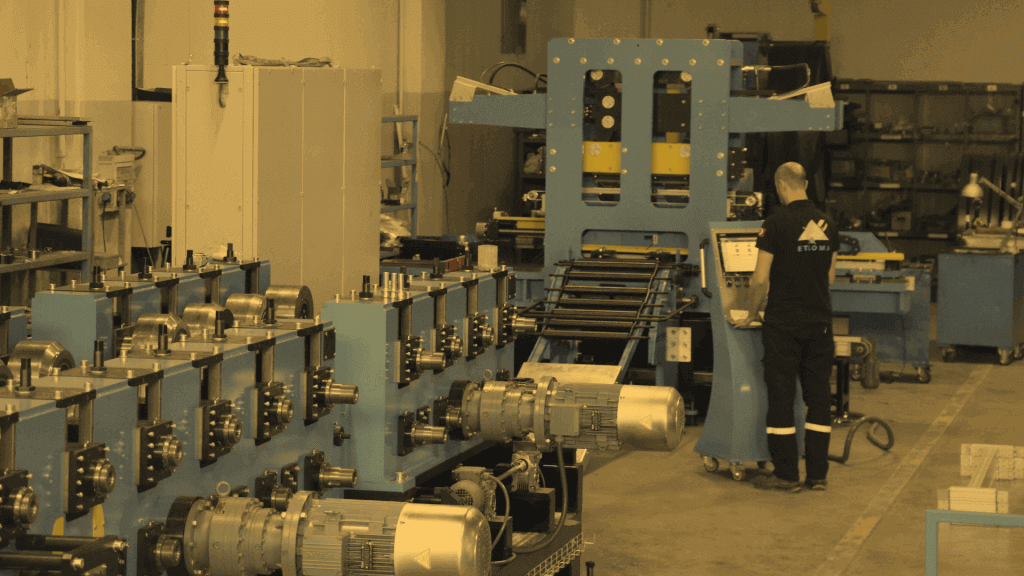
Is rolling that “one off” job really worth it?
Over the years we at Total Rollforming have fielded multiple phone calls from customers who either needed our help to set their machine before running an out of spec job, or needed urgent help because a “one off” job is not running properly or even causing damage to their machine – sound familiar?
A couple of examples as follows;
- A customer trying to run stainless material through their Rollformer that resulted in significant drive issues, and upon closer inspection, widespread damage to the surface of the tooling that was never designed to run that material.
- Customer running an export order of 0.9mm galvanised coil through a 15yr old rollformer that normally ran 0.42/0.48mm material, who needed help setting the machine.
In example one, our technicians spent many hours onsite trialing different options to achieve drive, whilst also performing the balancing act of trying to alter lubrication levels in order to reduce the “pickup” that was starting to occur between the stainless coil and steel machine tooling. The job was eventually nursed through at slow speeds resulting in much longer than planned production times. As a result of severe pitting of the machine tooling from the stainless, the customer ended up having to also replace a number of rolls after the job was finished.
The hidden costs probably not factored into the pricing model were;
- Significant onsite hours by our technicians trying to resolve the problem
- Slower throughput of the job, meaning more labour hours required to run and pack it
- Delays to subsequent jobs meaning late deliveries and upset regular customers
- Overtime labour (at time and half) to catch up and get back on schedule
- Numerous machine rolls that needed to be replaced as the pitting damage caused by the stainless material was now transferring to regular material jobs.
- Estimated costs of at least $15,000 – $20,000
For job two, we were called in late Friday afternoon (of course) for a job that had to be run immediately as it was an export order and the container needed packing over the weekend before being collected for shipping early the next week.
The machine that normally ran 0.42/0.48mm material needed multiple adjustments in order to run the 0.9mm galvanised coil specified for this “one-off” job.
I know what some of you might be thinking – “0.42mm is less than half a millimeter more than normal capacity”, however the other way to look at it is that the 0.90mm material is almost twice the thickness that the machine normally, and capably, handles and that which it was designed for. Try putting twice as much specified load into the back of your truck and see what happens.
We ended up regapping the entire machine, had to loosen the tooling on the final few stages to allow the double thickness material to get through the finishing passes with fine roll clearances built into the tool design, and also significantly increased the hydraulic pressure on the shear in order to cut through the material, which still often required two shear cycles before getting through.
In the process of setting the machine and running trial sheets to ensure a profile close to what was required, we also chewed up a bit of coil to the point where the order couldn’t be completed as they ran out of material.(Remember this was an export order, so it involved another container being shipped with the remainder of the job, as the coil was not in stock and had to be ordered in).
Come Monday we had to set the machine back to run bread and butter orders, and at a later date revert to the 0.90mm galv settings once again to complete the order once more coil arrived. Then the problems started… In the months following this job we were called to repair a number of things that started failing. In all we replaced all the chains (likely stretched by the double thickness material), sharpened the guillotine blades, replaced cylinder seals that started to leak within days of completing the job and also a few bearings that presumably were damaged under the additional load combined with the fact they had probably been in the machine for the 15+ years it had been in operation.
The hidden costs probably not factored into the pricing model were;
- Significant overtime onsite hours by our technicians trying to achieve the profile in the late afternoon / evening.
- Slower throughput of the job, meaning more labour hours required to run and pack it
- Additional cost of shipping the 2nd container
- After the fact repairs and maintenance due to accelerated wear and tear from running this particular job
- Estimated costs of at least $10,000 – $12,000
These are just two examples of many many similar instances we have dealt with over the years. When all the unforeseen costs of these types of jobs are factored in, I suspect that the “good margins” expected on these “one off” jobs few other suppliers are prepared to produce are significantly reduced, and in some cases I am sure that the jobs ending being produced at a loss.
From a sales perspective I totally understand the lure of saying “Sure we can” to that job that everyone else has refused. The hope is that it builds great credibility and might be the catalyst for picking up that customers on-going regular work moving forward. The point is to make sure that you are factoring in all the likely by-products of running this job into the costing and production scheduling model so that it isn’t costing you money and existing customers in the process.
I regularly field calls asking “Do you think we can run X material (normally considerably thicker or harder than usual) through our machine??” and my response is always the same;
- You might end up needing to make numerous changes to the machine in order to get something close to compliant / saleable product – so allow time and money for setup and setting back to normal.
- If (and it’s often a big IF) you can run it, then you need to allow for elevated wear and tear on things like bearings and chain, aswell as blade sharpening and other unscheduled maintenance tasks after the fact so put that cost into the quote.
- It will likely take twice as long to run as a normal job so factor that into your schedule and labour allocation.
- And lastly – when factoring in all of the above – is it worth it? What are the margins like, and how likely are you to get recurring work as a result – because you might just lose some of your current customers in the process.
If infact it turns out that after including all the potential add-on costs that the job is still worth producing, then before committing I suggest you get a sample of coil and trial it because as we all know with rollforming, just because it should work doesn’t mean it will!
That’s it for my first foray into content writing on this platform. If you are still here, thanks for taking the time to read this – I hope that its provided some useful nuggets you can consider / apply to that next “one-off” job that comes through the sales office.
All feedback welcomed, and if you wish to discuss in more detail, dont hesitate to reach out.

